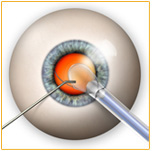Cataract Surgery

A cataract is a clouding of the eye’s naturally clear lens. A cataract may not need to be treated if your vision is only slightly blurry. Surgery is the only way to remove a cataract. The success rate of cataract surgery is excellent. Improved vision is achieved in the majority of patients if other vision-limiting problems are not present.
It is performed on an outpatient basis, which means the patient can go home at the same day. The patient can continue most normal daily activities
In the cataract surgery, a small incision is done in the eye. The surgeon inserts a tiny probe into eye. The probe emits ultrasound wave that soften and break up the clouded lens which is removed by suction.The back membrane of the lens (called the posterior capsule) is usually left in place. An artificial crystal clear intraocular lens is implanted in the eye to replace the natural lens that was removed.
Lasers are not used in cataract removal surgery. However, the lens capsule (the part of the eye that holds the lens in place) sometimes becomes cloudy several months or years after the original cataract operation. If the cloudy capsule blurs your vision, an ophthalmologist can perform a second procedure using a laser. This procedure, called a posterior capsulotomy, uses a laser to make an opening in the cloudy lens capsule, restoring normal vision.
Serious complications of cataract surgery like infection, bleeding or detachment of the retina rarely occur. Even if cataract surgery is successful, some patients may not see as well as they would like to. Other eye problems such as macular degeneration (aging of the retina), glaucoma, or diabetic retinopathy may limit vision after surgery. Even with these problems, cataract surgery may still be worthwhile.
Last Updated: October 23, 2024














